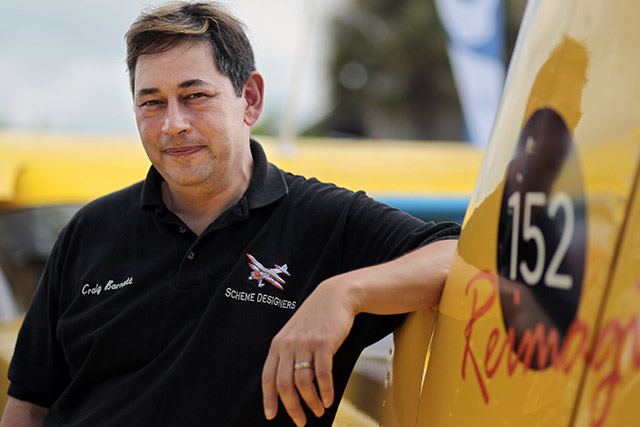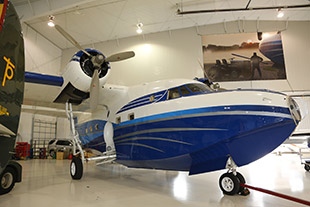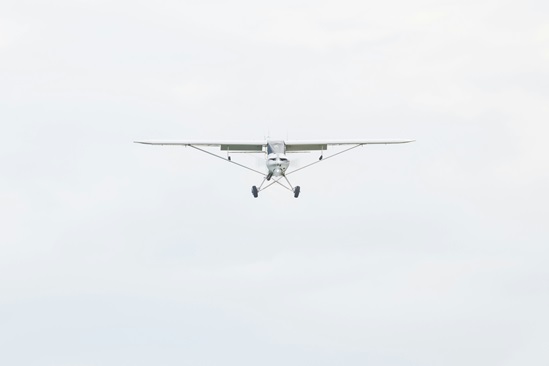
Frequently copied designer Craig Barnett
If imitation really is the sincerest form of flattery, then Scheme Designers founder Craig Barnett is an object of adulation.
During 18 years in business, Barnett and his seven-employee New Jersey design firm have created thousands of custom paint schemes for clients ranging from individual aircraft owners to international airlines. But Barnett’s copyrighted designs also have been mimicked countless times by private aircraft owners, commercial paint shops, and others—and Barnett says that’s not flattery. It’s theft.
 “I find it offensive when a paint shop blatantly rips off my work and then shows it off, claiming that it is their own,” says Barnett, a South Africa native who owns and flies a Beech Baron. “The worst part is that the rip-offs are usually poorly executed. My company and my employees earn less as a result of people stealing from us, and I’m getting tired of it.”
“I find it offensive when a paint shop blatantly rips off my work and then shows it off, claiming that it is their own,” says Barnett, a South Africa native who owns and flies a Beech Baron. “The worst part is that the rip-offs are usually poorly executed. My company and my employees earn less as a result of people stealing from us, and I’m getting tired of it.”
Scheme Designers has helped to create the distinctive look for many AOPA sweepstakes projects, including this year’s You Can Fly Cessna 152. He came up with the swirly red scheme for the 2001 AOPA Sweepstakes Bonanza, which has become one of the most common Bonanza schemes in the used Beechcraft fleet. When Barnett made a custom scheme for his former airplane, a Piper Lance, and posted it on the company website, a shop in the United Kingdom copied it before the paint on his own aircraft was dry.
“I’m not a litigious person, and I don’t want to be the bad guy in the aviation industry who goes around suing people,” Barnett said. “But a copyright doesn’t mean anything unless the holder enforces it, and I’m considering making a point when it comes to some of the most egregious examples.”
The definition of what constitutes original, artistic work that can be copyrighted is open to some interpretation. In broad terms, a simple stripe on the side of an airplane doesn’t meet the standard, but an elaborate, multicolored, one-of-a-kind scheme almost certainly does.
Manufacturers such as Textron and Piper have never sought to discourage aircraft owners or paint shops from re-creating factory schemes. Neither have the governments or squadron artists who came up with the insignia, nose art, and invasion stripes so popular among civilian warbird owners.
But there’s at least one legal precedent that shows Barnett’s copyrights are enforceable.
The test came when Barnett made a custom design for a Grumman Albatross owned by Tony Phillippi of Minnesota; Phillippi and Barnett shared the copyright. A paint shop representing a customer in Australia called Barnett to inquire about hiring him to come up with another Albatross scheme, and Barnett sent the prospective client a disc containing detailed drawings of the work he had done for Phillippi and others. Barnett didn’t get the new job, but months later Phillippi saw Internet photos of an Albatross painted in a scheme identical to his own touching down in Sydney Harbour.
“Scheme Designers worked really hard to come up with an original design—and eventually we had an ‘aha!’ moment where we knew we had what we were after,” Phillippi said. “If the owner of the other airplane had asked, we certainly could have accommodated him. But stealing the design was just wrong.”
Phillippi sued and eventually compelled the Australian owner to pay a licensing fee that allows him to use the appropriated paint scheme for a certain number of years. “Craig Barnett is one of the good guys,” Phillippi said. “I went to court as much for him as myself.”
Phillippi and Barnett declined to specify the exact price of their license fee, but it’s an order of magnitude more than hiring Scheme Designers would have cost. “For the copier, the cost of a custom paint scheme is trivial compared to the potential penalty for a copyright violation,” Barnett said.
Scheme Designers’ prices range from $1,400 for a relatively simple single-engine aircraft to $5,000 for complex graphics on a Boeing Business Jet.
Those rates typically discourage Barnett and other designers from aggressively pursuing potential copyright violations, because doing so would cost more in lawyers’ fees and court costs than they could ever hope to recover.
The music industry faced a similar conundrum when Internet distribution turned its traditional business model upside down. Its answer was to lower the price for individual songs to $1—an amount most customers would pay rather than seek out pirated copies.
For now, Barnett said he is concentrating on sharing information about copyrights within the aviation industry—and especially paint shops.
Marc Rossi, an intellectual property lawyer, general aviation pilot, and Scheme Designers customer, said some aircraft owners who duplicate paint schemes are much like those who download pirated music: They aren’t aware that their actions are illegal, or that there’s any harm.
“Craig Barnett makes his living by creating one-of-a-kind, custom paint schemes—and when people copy them without providing any form of compensation, it devalues his services,” Rossi said. “People should respect other people’s property. When they copy something without permission, they’re taking something that doesn’t belong to them. It’s basic fairness.”
When a potential new customer wants to replicate an existing Scheme Designers paint job, Barnett asks his original client for permission to share it. About 80 percent of the time, the original owner says yes—especially if the new client is willing to make relatively minor changes.
Permission technically isn’t required if Scheme Designers owns the original copyright, but Barnett says he asks as a courtesy and honors the original client’s wishes.
Some aircraft owners hire Scheme Designers or other firms because they want their airplanes to be totally singular and instantly identifiable—and it means a great deal to them for their airplanes to stand out. Rossi, for example, spent months on a detailed plan for his Waco YMF–5D biplane, and he was thrilled with the finished product. Months later, however, another aircraft appeared sporting an identical scheme. At Rossi’s insistence, the second owner had his airplane partially repainted.
“I’m flattered people like my paint scheme, and I get compliments on it all the time,” Rossi said. “They say imitation is the sincerest form of flattery—but I don’t want to be flattered. I want a unique and distinctive-looking airplane. I spent many, many hours going back and forth with the designers to create exactly that.”
Barnett said he is encouraged that the somewhat abstract idea of copyrighted material is gaining traction in aviation.
He was at the 2015 Sun ’n Fun International Fly-In and Expo when a Piper Arrow owner came by his booth and unexpectedly wrote him a check. Barnett asked what it was for, and the Arrow owner ruefully admitted that he had copied a Scheme Designers paint job from the company’s website years earlier. After learning more about the firm and talking with Barnett, he realized how much thought and effort that went into each design, and that simply lifting an image from the company’s website had been tantamount to stealing.
Barnett was “surprised and delighted” by the pilot’s honesty, but he declined to accept the check. “I asked him to send it to a charity which we support—and he did,” Barnett said. “He felt guilty for having done something he later learned was wrong, and he made it right. No hard feelings.”
Email [email protected]
Pictured: Albatross owner Tony Phillippi worked closely with Barnett to produce this distinctive paint scheme. When another Albatross showed up in Australia with identical paint, Phillippi sued to enforce his copyright.
Pilots have sought to express their individuality through instantly identifiable paint schemes for more than a century. The “Red Baron”Manfred von Richthofen became the most well known of World War I.



